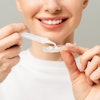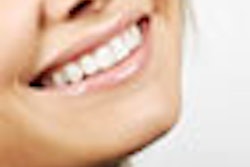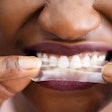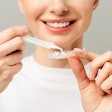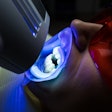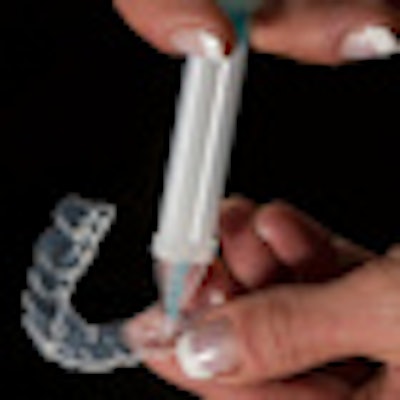
There has been a steady proliferation of whitening products for dentists and consumers, with some in-office products containing high concentrations (35%) of hydrogen peroxide.
In a recent study, Brazilian researchers set out to bolster the lack of published data regarding how bleaching can impact the mechanical properties of dental tissues (Journal of Dental Research, December 14, 2012). They took a molecular-level approach and found that high concentrations of hydrogen peroxide can have a dramatic impact on dental hard and soft pulp tissue.
"First, we are showing that 35% of hydrogen peroxide, used in commercial products, changes the enamel surface structure, increasing the roughness of these tissue," Fabio Nascimento, DDS, PhD, MS, a member of the research team from Biomaterials Research Lab at Universidade Bandeirante de São Paulo (UNIBAN), told DrBicuspid.com in an email. "The phosphate content in enamel and dentin also decreased after bleaching."
For this study, Dr. Nascimento and his colleagues were interested in the potential effect of 35% hydrogen peroxide (H2O2) on in vivo activity of dentin cysteine proteases and matrix metalloproteinases (MMPs). Their assumption was that H2O2 would promote collagen degradation in dentin because it increased the activity of proteolytic enzymes.
The study included 20 subjects (10 men, 10 women), ages 18-25, who were not tobacco users, had not received whitening treatment, had no gingival recession or restorations, and needed two to four first premolars extracted.
The participants were divided into two groups: bleached and nonbleached (control). The subjects in the bleached group had their right maxillary (n = 14) or mandibular (n = 14) first premolars bleached once per week with 35% H2O2 (Whiteness HP Maxx, FGM). Per the manufacturer's instructions, they received three 15-minute applications during each session. The subjects in the control group had their left upper (n = 14) or lower (n = 14) first premolars extracted without whitening treatment. In total, the subjects provided 56 teeth.
Ten teeth from each group were separated; the rest were used for dentin powder preparation. The researchers collected gingival crevicular fluid from the gingival sulcus of these remaining teeth (n = 36) prior to extraction. Postextraction, the teeth were sectioned, had their pulp removed, and the dental hard tissues were frozen.
Molecular analysis
The researchers analyzed the effect of 35% H2O2 under clinical conditions using various imaging methods. Teeth from the experimental and control groups had enamel surface morphologies examined with atomic force microscopy (AFM). The researchers also collected infrared spectra from the enamel and dentin powders of both groups using a spectrometer and a spectrofluorometer. Then they analyzed dentin specimens from either group with confocal fluorescence microscopy. Finally, they measured the presence of reactive oxygen species in the pulp tissue with spectrofluorometry.
“Bleaching is far from a cosmetic procedure.”
"In my opinion, this study is particularly interesting because it is an in vivo clinical study with a molecular approach," Dr. Nascimento noted.
The AFM images revealed a smooth surface on the control specimens, while the experimental set had "a much more irregular surface, with several spikes of larger size with deep microporosities," the researchers noted.
The impact on dentin was noteworthy as well. "The expression of collagen degrading enzymes increased substantially, promoting further degradation in the organic matrix of dentin," Dr. Nascimento stated.
Both the enamel and dentin were affected. "The bleaching agent containing 35% H2O2 induced a significant in vivo alteration in enamel and dentin, which could potentially trigger biological and/or mechanical responses of dental structures," the study authors wrote.
Limiting the damage
As a result of these findings, the researchers take issue with common characterizations of teeth whitening. "Despite reports that the use of bleaching agents at low concentrations has been considered absolutely safe, analysis of our data shows that the use of 35% H2O2 as a bleaching agent ... can be clinically adverse in the long-term and/or after recurring bleaching treatments."
According to Dr. Nascimento, ways to limit the amount of damage of high-concentration hydrogen peroxide to the inner layers of tooth tissue include the following:
- Reducing the hydrogen peroxide concentration
- Reducing the time of each application and increasing the time between applications
- Not using reaction catalysts, such as lamps or lasers
He and his colleagues hope their study findings reach patients as well. "We would like to demonstrate that an in-office bleaching is far from a cosmetic procedure, and it would be great if the clinicians could explain better to their patients about the pros and cons of using this procedure," Dr. Nascimento noted.
Dentists should also be aware that postbleaching sensitivity is mostly due to a slight inflammation into the pulp chamber (reversible pulpitis) that actually can progress for some undesirable pathology, he added.
"[It] is important to say that bleaching is not at all a dangerous procedure, but the dentists and the patients should know that sometimes the price paid by a purely aesthetic treatment may be too high at the end if the dentist is not sufficiently cautious in applying the bleaching agents," Dr. Nascimento concluded.

